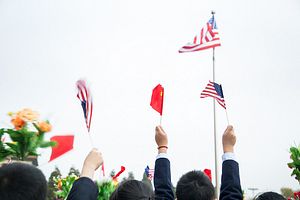Trans-Pacific View author Mercy Kuo regularly engages subject-matter experts, policy practitioners, and strategic thinkers across the globe for their diverse insights into U.S. Asia policy. This conversation with Dr. Øystein Tunsjø ̶ Professor and Head of the Asia program at the Norwegian Institute for Defense Studies and author of The Return of Bipolarity in World Politics: China, the United States and Geostructural Realism – is the 176th in “The Trans-Pacific View Insight Series”.
How does the current bipolar system differ from that of Cold War?
Structurally, the bipolar system in the 21st and the 20th century is similar. Two states are much more powerful compared to any other state and no third power is able to challenge the top two. However, as the world enters a new era of U.S.-China superpower rivalry, it differs from the U.S.-Soviet rivalry of the second half of the 20th century. Its core difference can be summarized in the phrase, “it’s geopolitics, stupid.” The new superpower rivalry is largely at sea, rather than on land. As a result, in some respect there will likely be more instability at the new power center in East Asia than there was in Europe during the previous bipolar period. Water barriers are likely to prevent a major war, but it increases the risk of a limited war directly involving the United States and China in maritime East Asia.
What are the highest geopolitical risks in U.S.-China relations?
The most important feature of the new superpower rivalry, increasing the risk of a limited war, is that it will be concentrated in the maritime domain of East Asia and not on the landmass of Europe. During the previous superpower rivalry concentrated on Europe, the United States was inferior to the Soviet Union’s land power. The United States had to rely on nuclear weapons in order to deter and prevent a Soviet attack on Western Europe. There was a high risk that any crisis or conflict could escalate into a major, plausibly nuclear, war. A galloping arms race, severe tension, and profound hostility followed, but Europe remained stable and peaceful.
In contrast to Europe [and the former Soviet Union], none of the United States’ most important allies in East Asia (Japan, South Korea, the Philippines, and Australia) borders China. Instead, water and U.S. naval preponderance protect these allies from China’s formidable land power. Consequently, the United States need not rely on nuclear weapons as heavily as it did in Europe in order to deter China. One might think that this is good for peace and stability, but the temptation of brinkmanship and the risk of war increases when the contenders rely on conventional rather than nuclear deterrence.
A future conflict might erupt in the South China Sea, the East China Sea, or the Taiwan Strait. In any case, the most likely scenario is a limited war constrained to the sea, that would not result in an invasion of China, the United States, or its allies, but would likely result in devastating attacks on the military infrastructure of both sides. If core interests are at stake, decision makers might be willing to risk a limited war or a constrained battle at sea in maritime East Asia, calculating that escalation to a major war is avoidable.
Evaluate current media characterization of U.S.-China relations in a new “Cold War.”
The “Cold War” analogy neglects the important geopolitical differences between the previous bipolar system concentrated on continental Europe and the current bipolar system concentrated on maritime East Asia. Two additional aspects are also important. First, some observers think that Russia and the United States are in a “new” Cold War. This view is misguided. China’s nominal gross domestic product is about ten times larger than Russia’s and its defense spending roughly four times Russia’s. The only power posing a major challenge to the United States today is China, not Russia.
Second, while the new superpower rivalry contains political, military, strategic, economic, and technological competition, the current era of globalization and economic interdependence is vastly different from the independence and East-West divide of the Cold War era. Together with the geopolitical differences, this will give the new bipolar system different characteristics compared with the Cold War.
Briefly explain how policymakers should understand “geostructural realism.”
Geostructural realism contends that although it is important whether the international system is bipolar or has some other structure, stability and balancing are heavily affected by geopolitics and the way in which geography affects the two superpowers and their relationship. The features of the previous bipolar system were strong balancing, stability, and strong competition and rivalry at the periphery. The contemporary bipolar system is characterized by moderate balancing, instability, and limited competition and rivalry at the periphery. Geostructural realism accounts for these different structural effects.
What are the U.S. foreign policy implications of geostructural realism with regard to U.S. leadership in the Asia Pacific?
Since its foundation in 1949, the PRC [People’s Republic of China] has never been more secure along its borders than now. It can therefore concentrate more resources and military capabilities on challenging the U.S. in maritime East Asia. The vastness of the Pacific Ocean, limited geographical space for forward U.S. military presence in East Asia, and large geographical distances between U.S. allies and partners in the region are geostrucutral conditions that will constrain U.S. leadership in a new era of U.S.-China superpower rivalry. The effects of a new bipolar system are likely to polarize international politics and the United States leadership will be more affected by how states adjust to the new superpower rivalry.

































